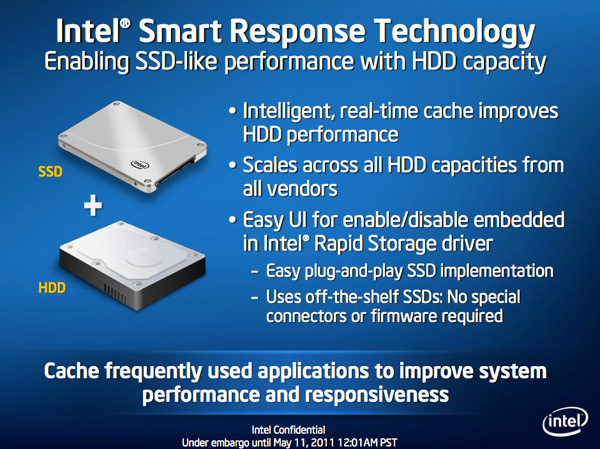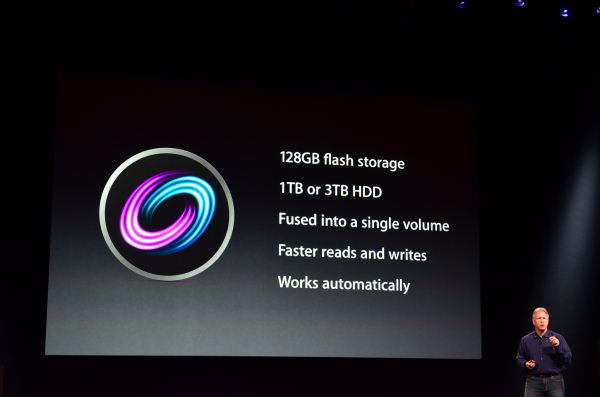A Month with Apple's Fusion Drive
by Anand Lal Shimpi on January 18, 2013 9:30 AM EST- Posted in
- Storage
- Mac
- SSDs
- Apple
- SSD Caching
- Fusion Drive
When decent, somewhat affordable, client focused solid state drives first came on the scene in 2008 the technology was magical. I called the original X25-M the best upgrade you could do for your system (admittedly I threw in the caveat that I’d like to see > 100GB and at a better price than $600). Although NAND and SSD pricing have both matured handsomely over time, there’s still the fact that mechanical storage is an order of magnitude cheaper.
The solution I’ve always advocated was a manual combination of SSD and HDD technologies. Buy a big enough SSD to house your OS, applications and maybe even a game or two, and put everything else on a RAID-1 array of hard drives. This approach works quite well in a desktop, but you have to be ok with manually managing where your files go.
I was always curious about how OEMs would handle this problem, since educating the masses on having to only put large, infrequently used files on one drive with everything else on another didn’t seem like a good idea. With its 6-series chipsets Intel introduced its Smart Response Technology, along with a special 20GB SLC SSD designed to act as a cache for a single hard drive or a bunch in an array.

Since then we’ve seen other SSD caching solutions come forward that didn’t have Intel’s chipset requirements. However most of these solutions were paired with really cheap, really small and really bad mSATA SSDs. More recently, OEMs have been partnering with SSD caching vendors to barely meet the minimum requirements for Ultrabook certification. In general, the experience is pretty bad.
Hard drive makers are working on the same problem, but are trying to fix it by adding a (very) small amount of NAND onto their mechanical drives. Once again this usually results in a faster hard drive experience, rather than an approximation of the SSD experience.
Typically this is the way to deal with hiding latency the lower you get in the memory hierarchy. Toss a small amount of faster memory between two levels and call it a day. Unlike adding a level 3 cache to a CPU however, NAND storage devices already exist in sizes large enough to house all of your data. It’s the equivalent of having to stick with an 8MB L3 cache when for a few hundred dollars more you could have 16GB. Once you’ve tasted the latter, the former seems like a pointless compromise.
Apple was among the first OEMs to realize the futility of the tradeoff. All of its mainstream mobile devices are NAND-only (iPhone, iPad and MacBook Air). More recently, Apple started migrating even its professional notebooks over to an SSD-only setup (MacBook Pro with Retina Display). Apple does have the luxury of not competing at lower price points for its Macs, which definitely makes dropping hard drives an easier thing to accomplish. Even so, out of the 6 distinct Macs that Apple ships today (MBA, rMBP, MBP, Mac mini, iMac and Mac Pro), only two of them ship without any hard drive option by default. The rest come with good old fashioned mechanical storage.
Moving something like the iMac to a solid state configuration is a bit tougher to pull off. While notebook users (especially anyone using an ultraportable) are already used to not having multiple terabytes of storage at their disposal, someone replacing a desktop isn’t necessarily well suited for the same.

Apple’s solution to the problem is, at a high level, no different than all of the PC OEMs who have tried hybrid SSD/HDD solutions in the past. The difference is in the size of the SSD component of the solution, and the software layer.










127 Comments
View All Comments
name99 - Friday, January 18, 2013 - link
Yeah, and USING Momentus XT sucks. The experience is horribly uneven.Enough stuff comes up fast that you get used to that, but enough stuff comes up slowly that it's REALLY noticeable because you're used to the occasional bursts of speed.
I've used Momentus, I've used Fusion. There is no comparison.
In fact (true story) after I replaced the broken HD in a friend's MacBook Pro with a Momentus she told me a week later that she thought the computer was still broken because it seemed to behave so strangely, sometimes feeling really fast, then a little later feeling so slow.
Now, if Momentus were kitted out with
- 64GB (maybe even just 32GB) of
- FAST flash (not the cheap crap used in USB thumb drives) AND
- cached writes
it might work well. But that's not the product that Seagate is selling.
Death666Angel - Friday, January 18, 2013 - link
2 of your 3 points are very correct. But they do use SLC which is not the cheap stuff.name99 - Friday, January 18, 2013 - link
If they do use decent flash, then why don't they cache writes?I always assumed it was because their flash (like USB thumb flash) was so crappy that it was slower for random writes than the HD was.
kyuu - Saturday, January 19, 2013 - link
Because there's a lot more to it than just using the right NAND. Also, for the 2nd-gen Momentus XT they were going to release a firmware update that would enable write caching. I'm not sure if that ever happened, haven't followed up on it recently.kyuu - Saturday, January 19, 2013 - link
That's because the MacBook/MacOS sucks. Not the Momentus XT's fault.Been using a Momentus XT in a Windows machine for a long time, had no problems with it being "uneven".
Also, they sure as hell don't use cheap flash "used in USB thumb drives".
ShieTar - Saturday, January 19, 2013 - link
How would the HDD know what is a file? The OS will just command a drive to write a given data block to Sector X.The drive may treat X as a logical address, and reorder data internally, but it has no clue if it is writing a complete file or parts of it, or just writing zeros as ordered by some secure erase software.
Subyman - Friday, January 18, 2013 - link
Any word on how much the migration process increases read/write quantity over a manually managed setup? As for ssd life being longer than hdd life, if we take into account that almost all writes will hit the ssd first and then some will transfer to the hdd this means the hdd is accessed less often. This could level the mean read/write to failure rate to make the hdd even with the ssd, unless migration has an effect that I'm not considering.dimmer - Friday, January 18, 2013 - link
Did you enable TRIM or not?name99 - Friday, January 18, 2013 - link
It's a Mac for gods sake. It comes configured correctly (yes, with TRIM enabled) out the box.alanh - Friday, January 18, 2013 - link
For me, the biggest problem is the added difficulty of doing an upgrade or replacement of storage if it starts getting full or goes bad. From what I've read, the only option is to do a full backup, replace one of the disks, and then do a full restore. I have an '11 MBP with SSD and the DVD replaced with a large HD, so I could, in theory move to a Fusion drive, but it just seems like a risky and annoying proposition.